Searching for snakes to clear path for dual-carriageway
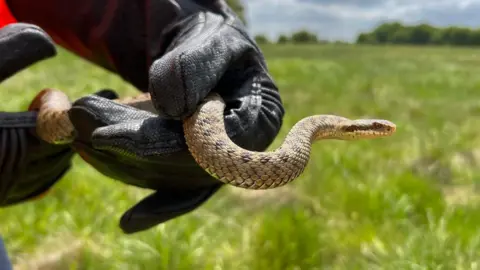 BBC
BBCEngineers and ecologists are joining forces to search for snakes, to clear the way for a long awaited new road.
The A417 connects Gloucester to Swindon, but a three-mile section through the Cotswolds is a single carriageway, causing major hold-ups for motorists.
A new £460m dual-carriageway is to be built, cutting journey times and reducing pollution.
But first, the engineers have to find all the snakes.
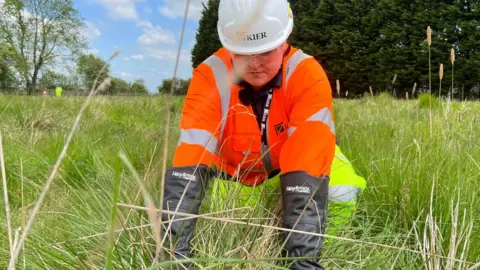
Natasha James looks every inch a builder, covered top to toe in high-vis, boots and a hard hat.
Only her long heavy-duty gloves suggest different skills.
She works for the construction firm Kier Highways, but as an ecologist.
Before the 30-tonne excavators can get to work on the Cotswold landscape, carving out a route for the new road, Ms James' team must find vulnerable adders, lizards, slow worms and more.
And then move them to safe new homes, far from the diggers and road noise.
'Needle in a haystack'
"We're lucky in Gloucestershire. We have quite an abundance of adders," she tells me.
"They are a native species to the UK, but we need to ensure their survival.
"So on this project we are moving all the reptiles that we find to receptor sites, where we have enhanced the habitat for them."
First we have to find them.
We set out together across a field of rough grass and vegetation. Natasha stoops, spreads the long grass back, looks carefully in promising spots where an adder might hide.
It seems to me like the ultimate needle in a haystack search.
"It is really," she laughs. "It can take an hour, or several, depending on the weather - and luck!"
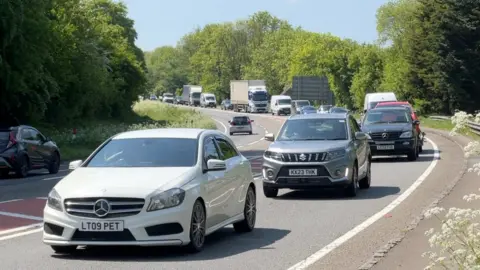
Suzanne Hall-Gibbins is eager for the snake-hunters to complete their work, so the diggers can get cracking.
She runs a business leadership firm, C2S, and criss-crosses the Cotswolds every day, meeting company bosses.
I take a ride with her down the A417 from Cheltenham towards Cirencester.
We don't get far.
"Look at this: typical!" she sighs. "It's midday, not rush hour, and we've ground to a halt already."
Missing link
In front of us, a lorry sits idling, red brake lights on. Behind us, the traffic stretches back half a mile. The satnav shows a long, tedious streak of red.
"It really is the the 'missing link' between the M5 and the M4," Ms Hall-Gibbins explains.
"This road is vital, not just to Gloucestershire but the whole wider community. Getting people through into Swindon, to the Thames Valley, delivering goods, getting people to work and school."
Up the road in Cheltenham, I meet a man who has put a figure on the traffic jams.

Steve Rich tells me hold-ups cost his firm £25,000 a year. He runs the logistics for Creed, a food service company delivering to schools and care homes, pubs and restaurants across the country.
Half their lorries head east, down the A417, straight into the jams.
"We hear about it from drivers every day," he tells me.
"It's a general topic of concern and moaning, the endless delays. Not just for our lorry drivers, but our staff too, trying to get in to work."
The A417 is constantly busy, 40,000 vehicles use it every day.
But as it winds its way through the Cotswolds, it has always been a challenge to widen it.
There are steep hills, twisting valleys to navigate. And all in a protected 'Area of Outstanding Natural Beauty', with tight rules on where and how roads can be built.
One of them is to protect the creatures that already live there.
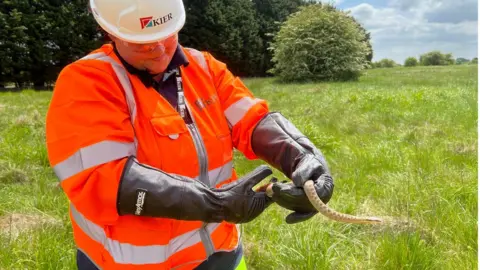
Back in her field, Natasha James calls me over, with quiet suppressed excitement.
"I've found one!", she says, holding a gently writhing adder in her gloved hands.
"She's nice and healthy, she's a breeding female, and we can take her to be with all the others now."
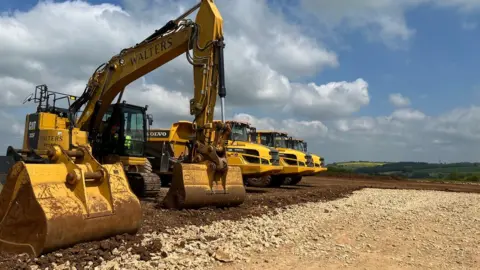
Ms James reckons her team of ecologists will have moved all the snakes and lizards by August. They are also planting six miles of hedgerows, 25 hectares of woodland and creating new habitats for birds, bats and bees.
In October the way will be clear for the diggers to start.
Dualling 'a long time coming'
For the last six years, Mike Goddard has led the project team for National Highways.
He said: "We're aiming to have the new road open in the summer of 2026.
"We've had some problems with the spring weather, like everyone, but now we're on time and on budget."
Lorry drivers and commuters, holiday-makers and students will all be pleased to see the end of the jams on this road.
Suzanne Hall-Gibbins has been campaigning for a dual-carriageway here for 15 years.
"It's been a long time coming", she says.

Follow BBC West on Facebook, Twitter and Instagram. Send your story ideas to: [email protected]
